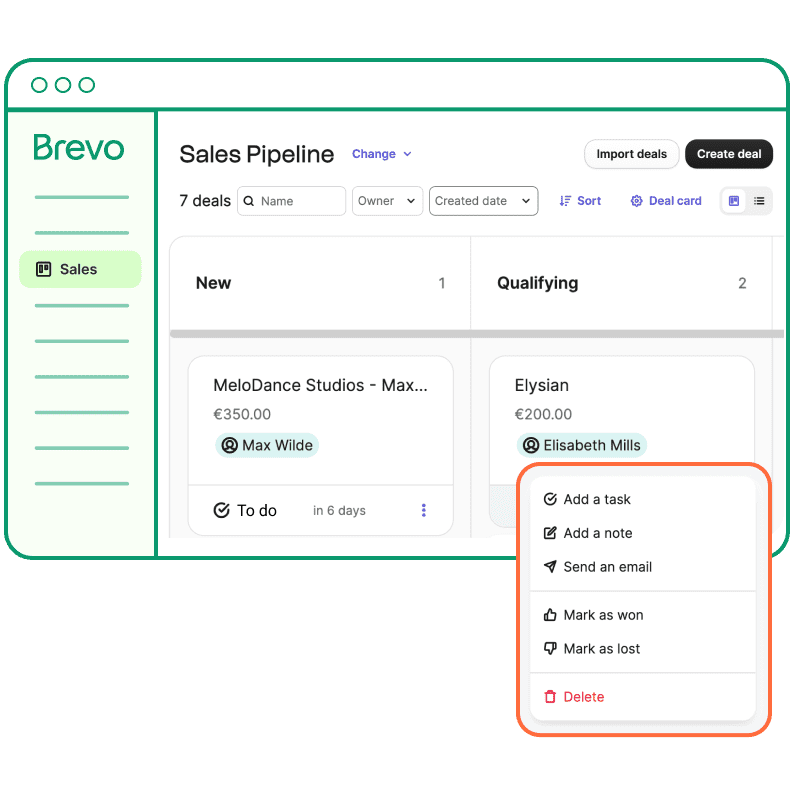
Distinguishing between CRM vs CDP can be tricky, especially since they both have to do with data management. While they have a lot in common and even work together to help businesses perform, they each have a separate purpose.
Table of Contents
What’s the difference between a CRM vs CDP?
Customer relationship management (CRM) platforms and customer data platforms (CDP) both use customer data.
CDPs consolidate data about customers from the entire business ecosystem and work to clean, analyze, and prepare data to be used by teams and in other business tools (like a CRM). CRMs, on the other hand, use data for customer-facing tasks, like creating and analyzing marketing campaigns and sales pipelines.
If customer data platforms are the brains, then CRMs are like the hands. They act on the information and insights that the CDP provides.
What is a CRM (customer relationship management) platform?
CRM software helps businesses manage customer relationships and interactions. Marketing, sales, and customer support teams use CRMs to create a personalized customer experience at every stage of the customer journey.

A sales pipeline in Brevo’s CRM software
Below are key use cases for CRM software.
Create customer experiences
CRMs are first and foremost a customer database. Customer-facing teams create digital marketing campaigns and deal pipelines for customers in this database using tools in the CRM.
They can then analyze the performance of customer interactions with reports. A history of all customer interactions are stored in the CRM so teams can improve future campaigns, sales funnels, and customer support.
All-in-one CRMs offer the following core platforms for creating a holistic customer experience:
- Marketing platform. Reach customers with relevant messages and tailored campaigns whatever channel they’re on. WhatsApp marketing, SMS marketing, email campaigns, signup forms, and marketing automation are some of the core features that drive engagement.
- Sales Platform. Encourage new and returning customers through the sales funnel with deal pipelines. Understand reasons for deal wins and losses with sales reports, and nurture prospects with lead scoring.
- Conversations Platform. Provide support for customers and prospects and keep them up to date on offers. Use SMS, WhatsApp, live chat, chatbots and more to connect with prospects.
- Messaging API. Set up triggered and transactional messages. Send order updates, password resets, automatic replies, and key notifications.
Streamline teamwork
CRMs simplify teamwork. Shared dashboards make information on customers and campaigns easy to find for everyone. Colleagues can assign each other tasks and create marketing automation workflows to send emails and update customer profiles.
Do more with integrations
You can connect your CRM to your other business apps using plugins and integrations to outfit your CRM with more tools.
If you have a CRM that can’t do SMS marketing, for example, you can always get a plugin for another app that does (or use Brevo, which is fully equipped with multi-channel marketing features).
In short, CRM systems are great at managing customer interactions, connecting teams, and personalizing the customer journey.
What is a customer data platform?
A customer data platform is software that collects data about customers from various data sources and unifies it into a single customer view. CDPs can enrich and process data in near real-time and sync this data to the rest of a business’s tools.

A CDP system visualization
Let’s take a look at common CDP use cases.
Unify customer data from many data sources
A CDP connects to your tools and centralizes data that would otherwise be scattered across your entire tech stack. Centralizing customer records gets rid of data silos and makes it available for the whole team. A CDP can connect with data sources, like databases, data warehouses, or using webhooks, APIs, integrations, flat files, and more.
Once all of this data is inside the CDP, it cleans and sorts the data in a process known as identity resolution. Identity resolution is creating a unified database of all customer information, free from duplicate profiles. The result is a single view of the customer.
So, what kind of data can a CDP collect?
The great strength of CDPs vs CRMs and DMPs lies in their ability to process all types of customer data: both “hot” and “cold” data, online and offline.

Types of data CDPs can process
The variety of data you can consolidate with a CDP is crucial for building a complete customer profile and understanding every touchpoint in the customer journey.
Your team can see which offers work best with your audience, which ads they click on, how they browse your website and so forth.
Hyper-personalize the customer experience
Once you have unified customer profiles in your CDP, you can analyze this data for powerful customer insights. These insights will help marketing teams and sales teams tailor their messaging, content, and interactions to each individual customer, such as sending messages at the perfect moment.
How?
With the help of CDPs, you can find patterns in data and use them to detect customer segments based on customer behavior, like shopping frequency and average cart order.
They can also be used to create scores that help you understand how customers are behaving. For example, a CDP can set up an engagement score to show how active each customer is with your brand.
Personalizing the customer experience isn’t just a question of CRM vs CDP, however. CRMs can also segment audiences with lead scoring workflows and pre-made segments for easy use.
Sync customer data to other business tools
Once all of your audience segments and customer profiles have been made (or updated), they automatically sync to your connected destinations and tools, saving your team countless hours updating profiles across different softwares.
In short, customer data platforms centralize and organize all data for each customer profile. Having accurate and enriched data empowers your team to take action. Your teams can better target and engage your customers. They can also closely monitor campaign performance.
Learn more: How Much Does Data Analytics Cost?
CDP vs CRM comparison
This table compares the key differences between CDP and CRM software.
If you need a master customer profile and powerful audience insights, a CDP is the software for your business. However, because CDPs process and enrich data with customer insights, CDPs come with a larger price tag.
Small businesses can enjoy many of the benefits of contact management with a CRM for a more affordable price (many CRMs can be tested for free, unlike CDPs).
How do you choose CRM vs CDP?
When comparing CRM vs CDP, you’ll notice that while they both build customer profiles. But CDPs easily take the crown here, as they create more comprehensive profiles and enrich them for better business performance.
However, CRMs can act on data that they get from CDPs. CRMs also serve as an important touchpoint for gathering customer data to send to CDPs to get enriched.
Ultimately, they work best together. Start managing data and developing customer relationships with a CRM. As the most approachable CRM software on the market, Brevo offers a free version for users to test out the platform.
Try the Brevo CRM Sales PlatformUnlimited contacts, deal pipeline management, tasks, inbox, automation, meeting scheduling — all in one place. |






